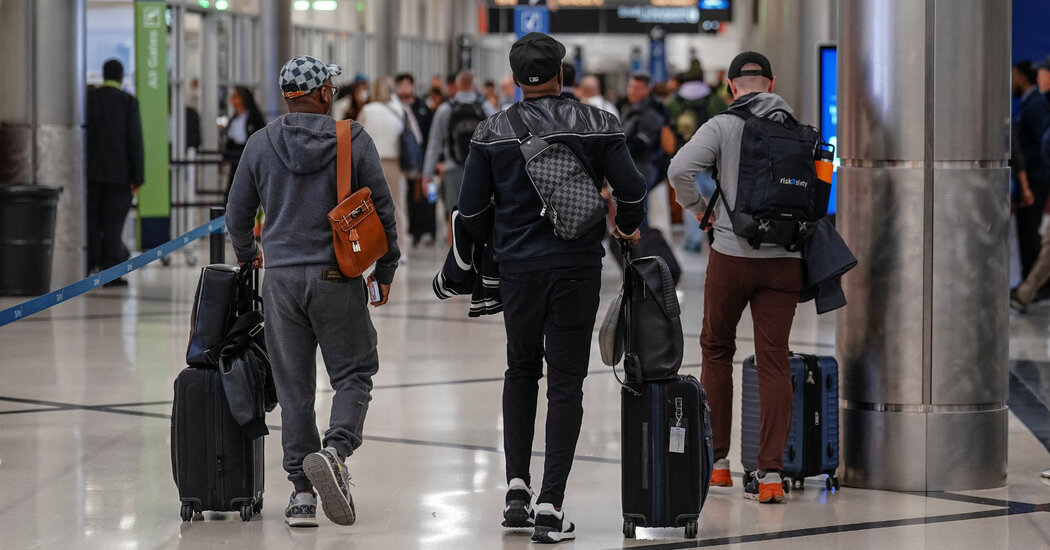Copyright The New York Times

Airlines on Thursday raced to rework plans and prepare customers and workers for disruptions this weekend, when a reduction of flights is set to take effect at the nation’s busiest airports. The cuts, which the Department of Transportation announced on Wednesday, will affect 40 airports and are intended to relieve pressure on air traffic controllers who have been working without pay since the government shutdown began last month. The affected airports, serving major cities including Atlanta, Chicago, Los Angeles and New York, are expected to see a 4 percent reduction in air traffic starting on Friday, rising to 10 percent by the end of the weekend. Airline planning and scheduling teams have been in overdrive identifying which flights to cut while minimizing consequences for customers, pilots, flight attendants and the bottom line. The government has not said whether it plans to play a role in determining which flights are cut. As of Thursday afternoon, while officials had shared a preliminary list of affected airports with the airlines, they had yet to make any such list public. “This is a huge endeavor at such short notice,” said Oliver Lamb, managing director at Ailevon Pacific Aviation Consulting. Airlines are “battle-hardened” and used to managing disruptions, he said, but this was a “big undertaking particularly as we head into holidays.” The nation’s four largest carriers, American Airlines, Delta Air Lines, Southwest Airlines and United Airlines, said that most customers would not be affected by the cuts, but that travelers who wanted to change or cancel a flight for a refund could do so. American, Delta and United said that long-distance international flights would continue as planned. Southwest does not offer such flights. Airlines are practiced at managing disruptions caused by bad weather, air traffic control staffing shortages, technological outages and other factors, but the scale of the government cuts eclipses that of most previous disruptions, experts said. Still, airlines said that the cuts would be targeted and the consequences limited. “Even with these schedule reductions, United and its United Express partners will still offer about 4,000 flights per day to fly our customers to their destinations,” the airline’s chief executive, Scott Kirby, said in a message to staff members this week. The airlines are expected to focus first on making cuts that will have the smallest impact, experts said. That may include trimming service on routes that have multiple daily flights or cutting less profitable or less popular flights to smaller airports. “To some degree, it gives airlines the opportunity to cancel stuff that they think is going to be a loser anyway,” said Bob Mann, an industry consultant and former airline executive. Delta said that the airline would reduce the number of flights on some routes, but that it intended to continue service to all of those destinations. United said that flights between its airport hubs would remain uninterrupted and that it would make cuts elsewhere. Some airlines may also be able to use larger planes to accommodate passengers on flights that were canceled. But making such changes isn’t easy. Flight schedules are determined months in advance, and changes can have cascading effects. A bad storm that affects airports in New York can have lingering effects for days across the country, for example, because it displaces not only travelers but also pilots, flight attendants and planes. Airline planners also have to take into account federal rules governing the working hours of flight crews. Pilots and flight attendants can spend only so much time on the clock before having to take mandated periods of rest between shifts. Experts said the timing of the flight cuts wasn’t too bad for airlines — for now. Flying is generally less congested in the weeks before Thanksgiving, which gives the industry some room to maneuver. “Because of the early November timing, our flights have more seats available than before the summer, meaning we should be able to find seats for many customers even if their flight is canceled,” Mr. Kirby of United said. But if the federal limits linger, travel around Thanksgiving, one of the busiest periods of the year, could be affected. With a majority of travelers booking well in advance and planes more full during the winter holiday period, airlines have “limited slack” in their schedules to minimize disruptions, said Clark Johns, a director at Alton Aviation, a consulting firm. Planes typically fly with 80 to 90 percent of seats occupied by passengers, but that share can rise well into the 90s around the holidays. Emmett Lindner contributed reporting.



